Bulletin – January 1995 Quarterly Report on the Economy and Financial Markets
- Download 164KB
The pace of economic recovery quickened in the second half of 1994. The latest national accounts recorded growth of 7.3 per cent in non-farm product over the year to the September quarter. Expenditure grew even more strongly. Partial data for the December quarter point to continued strong demand. This has spilled over into imports, enlarging the current account deficit. Some tentative signs of pressures on prices and wages have begun to appear, a trend which is likely to persist over the coming year. Assessments of the outlook for inflation prompted increases in official short-term interest rates of 1 percentage point in October and again in December.
Looking ahead, some forces are at work which will tend to slow the rapid growth. In particular, the housing cycle has peaked and the stock cycle is likely to detract from growth over the next year or so. Over time, the recent tightenings in monetary policy will operate to restrain demand. At the same time, expansionary forces remain strong. Although off their recent peaks, business and consumer sentiment are buoyant. With high profits and pressure on capacity, the investment surge still has some way to go. World growth is likely to provide further stimulus, with the US continuing to record robust growth and the recoveries in Europe and Japan taking firmer hold. Higher commodity prices will boost Australia's income and spending.
The relative strengths of these opposing forces will need to be monitored carefully over the months ahead. For the moment, the economy is growing faster than is sustainable over the longer term. This is helping to reduce unemployment, but it also runs the risk of closing the output gap too quickly, with attendant upward pressure on prices and wages. Some recent wage increases, such as those in parts of the transport industry, are not consistent with ongoing price stability (whatever the merits of individual settlements in terms of catch-up for earlier periods of restraint). Sustained growth in activity and employment depends on a number of factors, but an initial requirement at this time is that wages, in aggregate, rise no faster than 2 to 3 per cent plus productivity growth.
Economic Activity
The September quarter national accounts recorded stronger activity and spending than had been expected. The drought held down overall growth to 1.3 per cent in the quarter, but non-farm output rose by 2.1 per cent, bringing the rise over the year to the September quarter to 7.3 per cent. Expenditure grew by 8.3 per cent over the same period.
The strength was widespread. In underlying terms, private final demand rose by 2.6 per cent in the September quarter, reflecting strong growth in consumption, dwelling investment and especially spending on plant and equipment. Public demand and stock accumulation added further to overall expenditure. Private non-farm inventories contributed over 1 percentage point to growth in the year to the September quarter (although to the extent that this was unexpected and/or businesses expect less rapid growth in demand in future, additions to inventories will be reduced in the quarters ahead, thereby detracting from growth). On the income side, both wages, salaries and supplements and company profits grew strongly in the quarter.
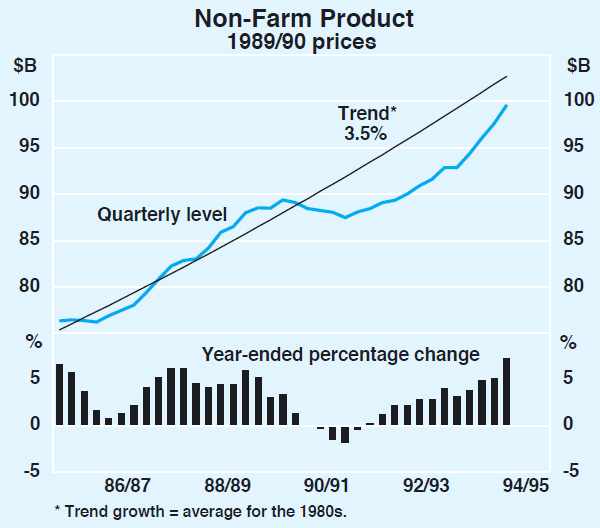
Graph 2 gauges the relative strength of recent recoveries by comparing the fastest twelve-month movement in four different variables – namely, the fall in unemployment; the rise in employment; the rise in non-farm output; and the rise in expenditure. However it is measured, the current recovery is as strong as any experienced in the past two decades.
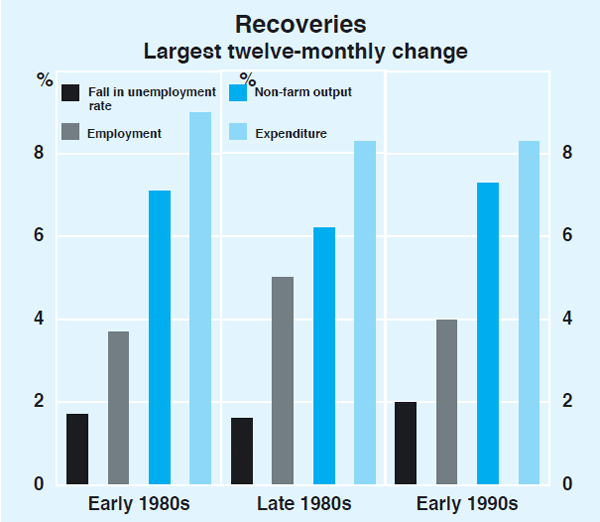
The household sector
Recent indicators of consumption expenditure continue to show strong growth. Although subject to considerable monthly volatility, the value of retail trade in the three months ended November was 2.0 per cent higher than in the previous three months, while passenger vehicle registrations rose by 4.7 per cent over the same period. Consumer sentiment also remains around the high levels reached in previous peaks (see Graph 3).
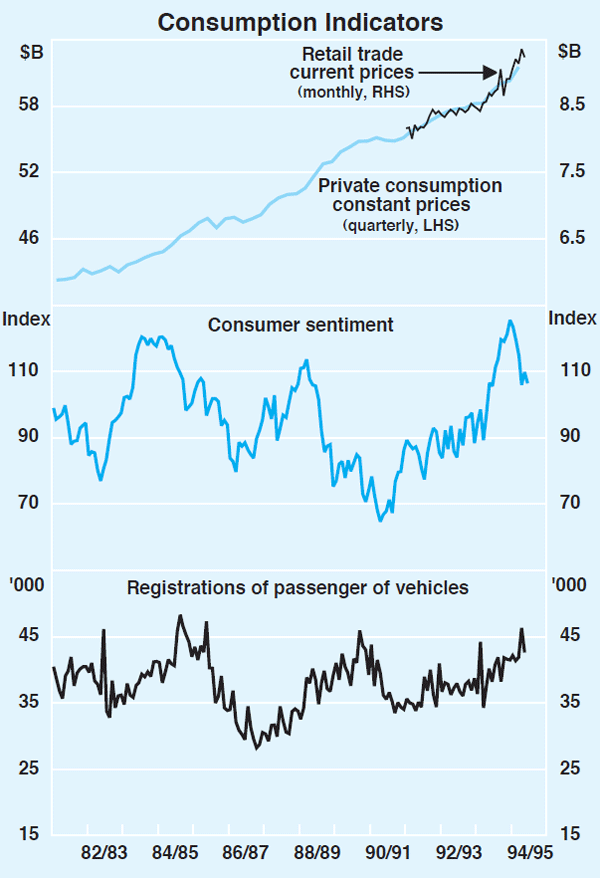
Strong employment growth, rising disposable incomes and continued high levels of consumer confidence should translate into further increases in household spending in the year ahead. On the other hand, higher interest rates have begun to affect housing affordability (a measure of the cash-flow burden of home finance), although that remains at favourable levels, compared with those prevailing over the past ten years (see Graph 4). More generally, the recent increases in interest rates can be expected to have a negative effect on the cash flow of the household sector, and to be a moderating influence on the growth of consumption expenditure in the year ahead.
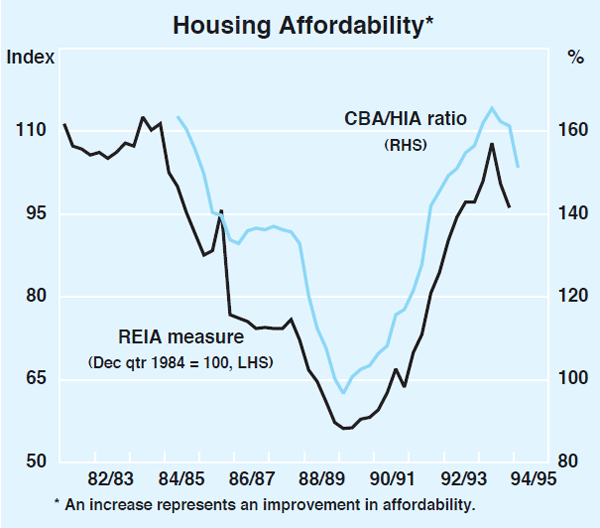
Recent data on housing indicators suggest the upswing in this sector, which led the economy out of recession in 1991/92, has largely run its course. The value of loan approvals (excluding refinancing) fell by 8.6 per cent in October, and preliminary data suggest a further fall in November. Loan approvals for the purchase of established dwellings are trending down a little more rapidly than are approvals for the construction of new dwellings. As in the late 1980s, loan approvals to investors held up longer than approvals to owner-occupiers, although they have now begun to turn down. Consistent with the fall in loan approvals, growth in the stock of housing credit outstanding has fallen below the peak rates of growth recorded earlier in 1994, although it still grew at an annualised rate of 17 per cent over the three months to November.
The slowdown in housing finance for new dwellings is starting to show up in the data for local government approvals for the construction of private dwellings (see Graph 5). These fell by 17 per cent in the three months to November, and are now below the high levels recorded a year earlier. The slowdown was restricted initially to approvals for houses (which have fallen in five of the past six months) but, more recently, some large falls have occurred in approvals for medium-density dwellings (including conversions from commercial buildings).
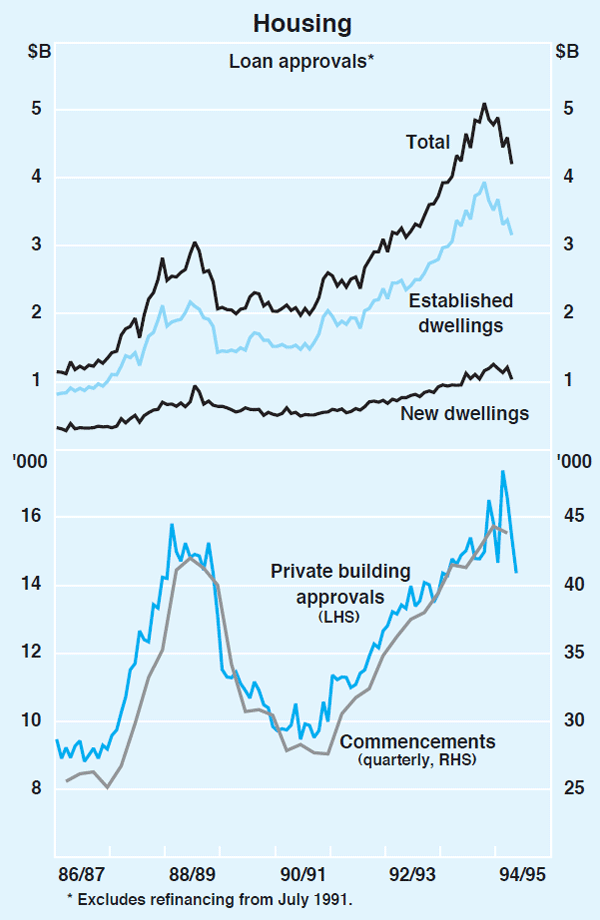
These data suggest that dwelling commencements will record a small fall in the December quarter, after falling by 1.1 per cent in the September quarter. For 1994/95 as a whole, the Indicative Planning Council for the Housing Industry predicts commencements of just over 160,000 dwellings, down from the historically high level of 178,000 in 1993/94. Since the latest upturn began in September 1991, some 450,000 dwellings have been constructed; this is nearly double the number in any upswing since 1972/73 (see Graph 6) and in excess of the underlying demand implied by demographic and social trends. Some retreat from current construction rates was inevitable, irrespective of monetary policy actions. House prices rose at a faster rate than general inflation over the year to the September quarter, with estimated increases ranging from 5 to 10 per cent. These average figures mask wide variations across regions, suburbs and dwelling types.
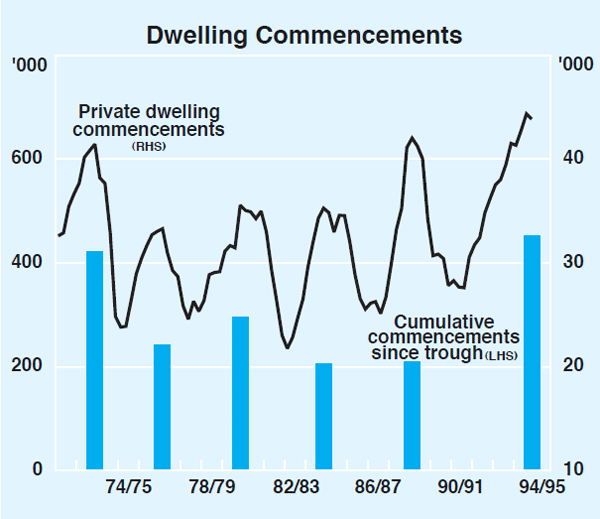
The business sector
Business conditions remain favourable, with strong demand coinciding with relatively low interest burdens. As a result, corporate gross operating surplus (GOS) increased by 7.1 per cent in the September quarter; GOS after interest rose by 6.8 per cent in the September quarter, and by 11.7 per cent over the year to September. Measured as either a share of national income or as a rate of return on assets, profits have returned to healthy levels. These profit levels, and general optimism about the future, have underpinned the strong recovery in investment in plant and equipment. The March and June national accounts had not captured the full extent of the turnaround in plant and equipment investment (see Graph 7), but the September accounts – with significant revisions to earlier figures – showed a clear recovery. In underlying terms, investment in plant and equipment grew by 30 per cent over the year to the September quarter. Non-dwelling construction also grew solidly, rising by nearly 4 per cent in the quarter and by more than 12 per cent over the year to the September quarter (Graph 8).
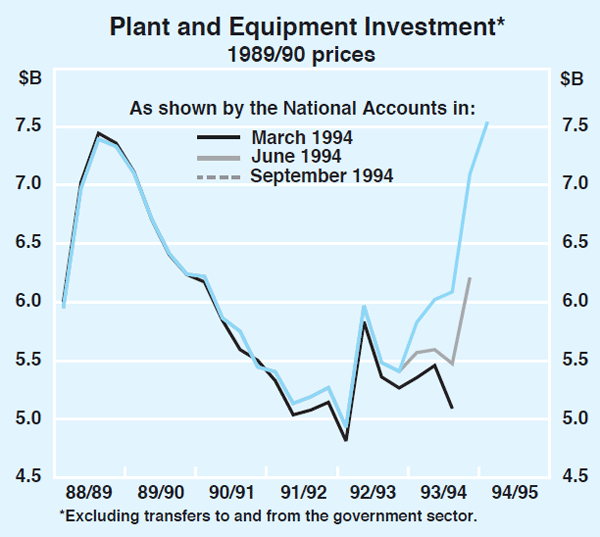
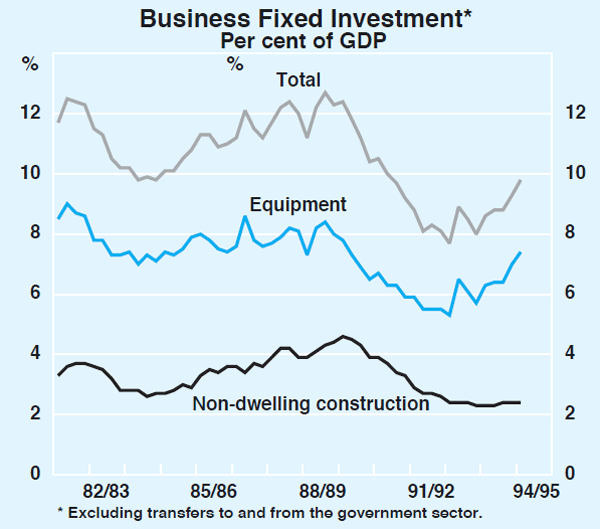
The September quarter capital expenditure survey suggests further strong rises in investment over the rest of 1994/95. These would return equipment spending as a share of GDP to the peak levels of the late 1980s, although the stock of capital, relative to output, would remain below its previous levels (given the extended period in which plant and equipment investment was very low by historical standards). Despite improvements in capital productivity, continuing high levels of investment in plant and equipment are needed to generate the necessary capacity to underpin sustainable growth. Investment in non-residential construction also is expected to rise significantly over the rest of the financial year, with hotels, shops and factories the favoured areas. Reflecting continued high surpluses, construction of commercial offices is expected to remain weak.
The latest ACCI-Westpac survey of manufacturers, conducted in late November/early December, reported a sharp fall in the number of firms expecting improved conditions over the next six months. Most firms, however, expected a continuation of present buoyant conditions, rather than a deterioration. The survey also reported continued solid growth rates for output, investment and profitability.
The public sector
In underlying terms, public final demand increased by 7.3 per cent over the year to the September quarter. Within this total, investment grew by 15.7 per cent, in part reflecting large, lumpy expenditure by public trading enterprises on new assets. Public consumption expenditure grew by 4.9 per cent. Public final demand now appears likely to make a greater contribution to overall growth in 1994/95 than was expected at the outset of the financial year.
The total public sector borrowing requirement (PSBR) was equivalent to 2.7 per cent of GDP in 1993/94 and, based on Commonwealth and State budget figuring, could rise to a bit over 3 per cent of GDP (over $14 billion) in 1994/95. In underlying terms (i.e. abstracting from sales of existing assets and redundancy payments), it could reach 3¾ per cent of GDP, somewhat above the Budget forecast of 3.4 per cent and about the same as in 1993/94. These estimates may not fully reflect the faster-than-anticipated growth in the economy, but do indicate a more expansionary fiscal stance than earlier thought.
The change mainly reflects increased state expenditures. Despite a good performance in bringing their budgets back towards balance in 1993/94, a number of States' capital and other expenditures will be higher in 1994/95 than earlier anticipated.
Rural conditions
The current drought is one of the worst on record. Virtually all of New South Wales and almost half of Queensland have been declared drought-stricken, while much of Victoria and southern South Australia are classified as seriously rain deficient. Recorded farm output fell by 18 per cent in the September quarter. Crop production (excluding sugar cane), which accounts for about 40 per cent of total farm output, fell by 27 per cent. The ABS apportions estimated annual crop production equally across the four quarters of the financial year. As a result, large movements are concentrated in September quarters. The effect of sharp falls in rural output on farm incomes will be mitigated to some extent by rising prices for wool and other commodities. The direct impact of the drought is estimated to reduce 1994/95 GDP by up to ¾ of a percentage point.
External Developments
The international economy has provided an increasingly favourable backdrop over recent months, bringing a further improvement in Australia's terms of trade. Strong domestic demand, however, has boosted imports, and the current account deficit has widened.
The international economy
Demand is strengthening in the OECD countries but, so far at least, this is occurring without any general pressure on inflation. The potential for higher inflation remains a concern, however, particularly for the US, and these concerns are reflected in continuing high levels of long-term interest rates around the world. Any dampening effect of those higher interest rates, however, seems to be out-weighed by the continuing momentum of the recovery in the US, and the stronger growth now emerging in Europe and Japan. The OECD has been progressively revising upwards its growth forecasts, with OECD area GDP now forecast to grow by 3 per cent in 1995 (Table 1). Prospects for growth in non-member Asian countries also remain strong.
| Made in December 1993 |
Made in June 1994 |
Made in December 1994 |
|
|---|---|---|---|
| United States | 2.7 | 3.0 | 3.1 |
| Japan | 2.3 | 2.7 | 2.5 |
| Germany | 2.2 | 2.6 | 2.8 |
| France | 2.7 | 2.9 | 3.1 |
| United Kingdom | 2.9 | 3.2 | 3.4 |
| European Union | 2.5 | 2.8 | 3.0 |
| OECD | 2.7 | 2.9 | 3.0 |
For some time, forecasters have been predicting that growth in the United States would slow, to a rate more in line with the long-term sustainable rate. So far, however, there are no clear signs of slowing, with GDP increasing by 1 per cent in the September quarter, bringing the growth over the year to 4.4 per cent. Employment and other recent indicators point to strong growth continuing in the December quarter. Capacity utilisation is at a five-year high and unemployment has fallen significantly below the 6 per cent level at which wage and price pressures are generally assumed to develop (Graph 9). So far, however, underlying inflation remains below 3 per cent and unit labour costs rose by less than 1 per cent in the past year, reflecting strong productivity growth. To help contain possible rises in inflation, the Federal Reserve further tightened monetary policy in mid November; most observers expect further increases in 1995.
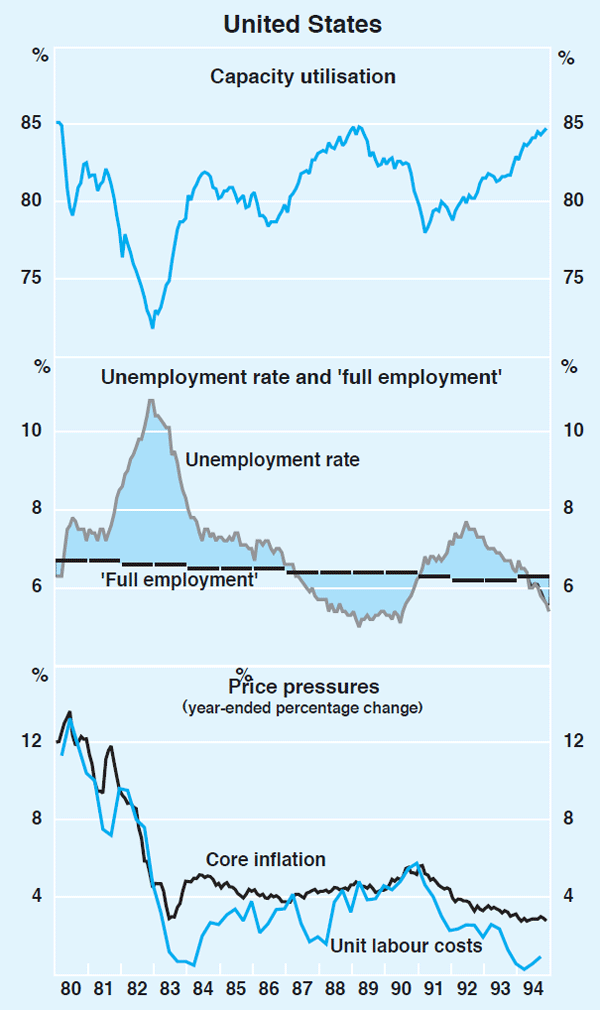
Recovery in Europe is gathering strength. The OECD has revised upwards its estimate of growth in the European Union in 1994 from 1.9 per cent to 2.5 per cent and is forecasting 3 per cent growth in 1995. Western Germany, France and the United Kingdom all recorded good growth in the September quarter. On Continental Europe, inflation prospects seem good, with earlier low wage settlements not yet reflected fully in lower inflation, and considerable slack remaining in labour markets. The recovery in the UK has been running longer, and the authorities have tightened monetary policy.
In Japan, strong public and private consumption underpinned a 1 per cent rise in GDP in the September quarter. More recently, retail sales have been weak, but a second round of income tax rebates in December (which will not be offset by indirect tax increases until 1997) will provide encouragement for consumption. Further evidence that investment has bottomed was contained in the Bank of Japan's November Tankan survey, which reported rising business confidence for the third consecutive quarter. Industrial production in November was 6 per cent higher than a year earlier.
The newly industrialised economies continue to expand at significantly higher rates than the OECD countries. In Singapore, GDP grew by 10 per cent in the year to September, while in Taiwan, GDP grew by 6 per cent. In China, industrial production in recent months has grown at an annual rate of over 20 per cent, but with inflation of 25 per cent over the twelve months to November. Asian countries have accounted for almost half the growth in world trade in recent years, and were particularly prominent in the early 1990s, when growth in OECD countries was slow. Asian countries, together with New Zealand, have accounted for all the growth in Australian exports over the year to September (see Graph 10).
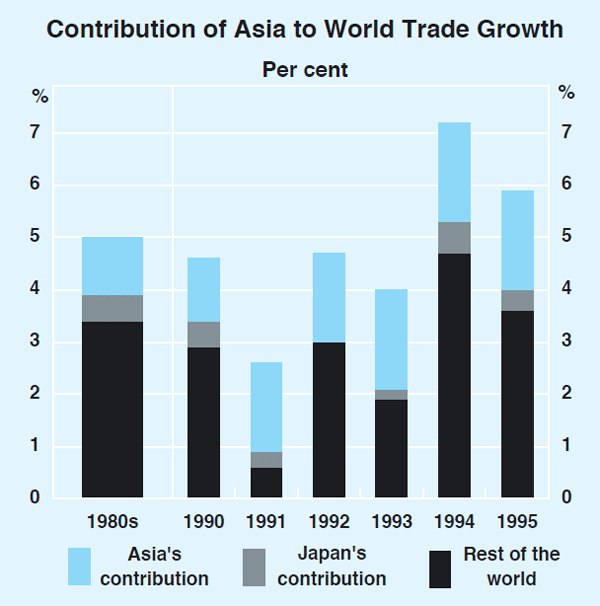
Reflecting the strength of world industrial production, commodity prices continued to firm through the December quarter (see Graph 11). The Reserve Bank's Commodity Price Index rose by 4 per cent in SDR terms over this period and is now 14 per cent above its trough in late 1993. The largest increases over the quarter were in prices for base metals (up 19 per cent), with particularly strong increases in nickel (34 per cent), aluminium (19 per cent) and copper (19 per cent); gold and oil prices fell slightly.
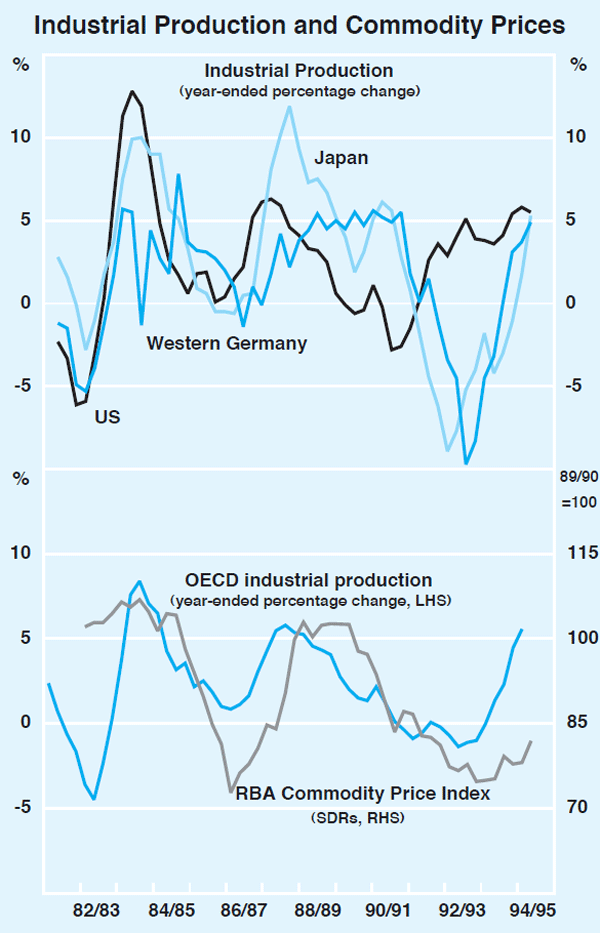
Some rural commodity prices also recovered in the December quarter, with disruptions to world supply being the main factor. Cotton and sugar prices were each up 15 per cent. Wool prices remained firm in the December quarter, with the Eastern Market Indicator averaging 771 cents per kg, around 53 per cent higher than a year earlier. Despite the appreciation of the Australian dollar, most of these increases have translated into increases in $A terms.
The rise in commodity prices since late 1993 and the appreciation-induced fall in the price of service imports resulted in Australia's terms of trade rising by 1.5 per cent in the September quarter, and by 2 per cent over the year to the September quarter. Further increases in the terms of trade appear likely given the continued improvement in commodity prices.
The Balance of Payments
Despite this generally-benign international environment, Australia's current account deficit has expanded markedly over the past six months or so (see Graph 12). The current account deficit averaged $1.8 billion in the three months to November, a little under 5 per cent of GDP. This compares with a deficit of 3½ per cent of GDP in the same months of 1993. Despite the likelihood of continuing improvements in the terms of trade, further increases in the current account deficit are in prospect as the effects of the drought, higher world interest rates and (especially) the spillover of rapid growth of domestic expenditure come together.
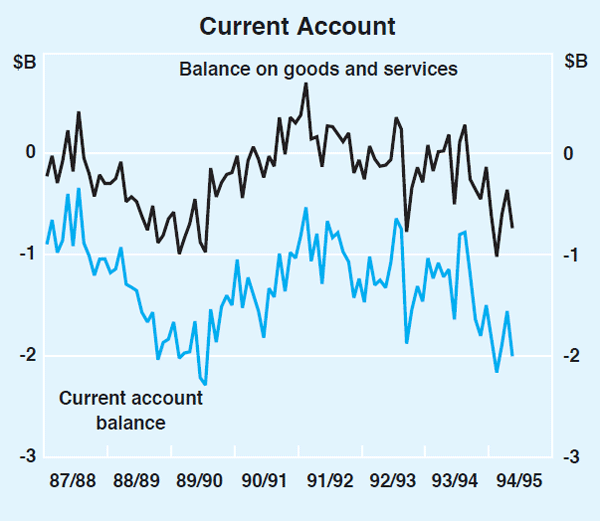
Import volumes grew by 8.5 per cent in the September quarter and at an annual rate of 30 per cent in the six months to September (Graph 13). All broad categories of imports grew strongly (Graph 14). More recent data (available only for values, not volume) suggest some easing in the growth of imports. The value of imports was 1.7 per cent higher in the three months to November than in the preceding three months.
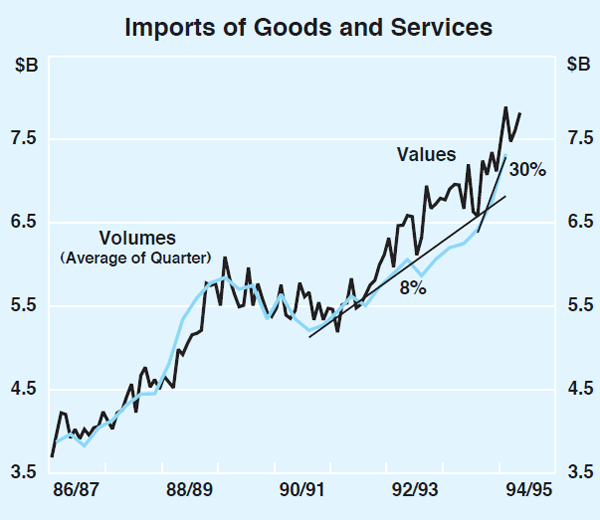
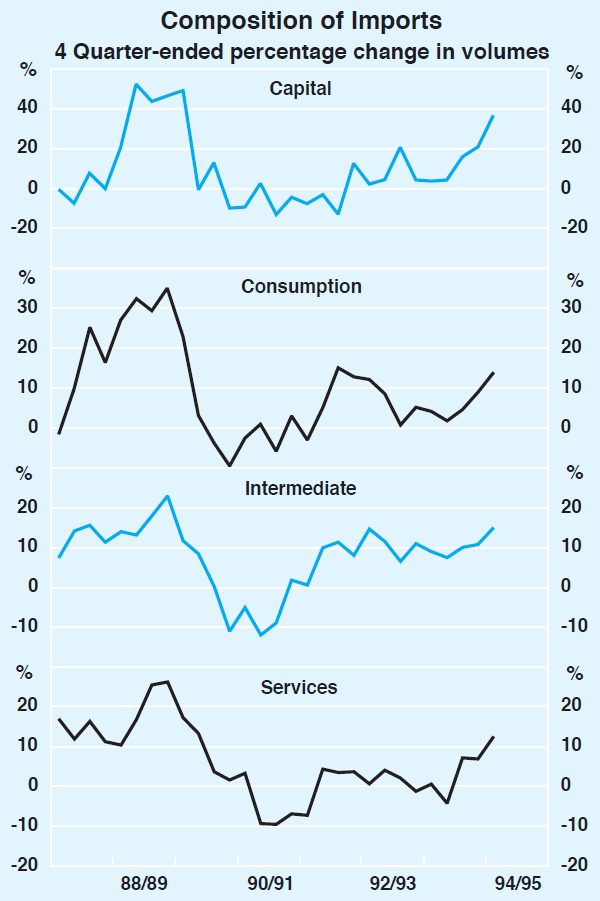
Notwithstanding the strength of world demand, the volume of exports fell slightly in the September quarter but was still 8 per cent higher than a year earlier. The decline in the quarter reflected a fall in resource-based exports; rural and manufactured exports rose slightly while service exports increased by 9.4 per cent. Recent monthly data point to a modest pick-up in the value of exports, with resource-based and manufacturing exports both growing strongly; the strength of resource (and some rural) exports appears largely to reflect higher prices.
Australia's estimated net foreign liabilities rose by $3.7 billion during the September quarter to $237 billion, or 55 per cent of GDP. Net capital inflows of $5.2 billion were partly offset by stock valuation effects of $1.5 billion. These liabilities are made up of both debt and equity. Net debt contributed $1.2 billion but these borrowings mask a further reduction in non-official borrowings, a trend evident over the past two years. Aided by valuation effects, the stock of net debt fell by $2.5 billion to $160 billion, around 37 per cent of GDP, which is 5½ percentage points below the peak in September 1993.
The Outlook for Inflation
Inflation remains low, with the Treasury and other measures of underlying consumer price inflation running at around 2 per cent per annum – as has been the case for nearly three years. The headline CPI increased by 0.6 per cent in the September quarter and by 1.9 per cent over the year to the September quarter (see Graph 15).
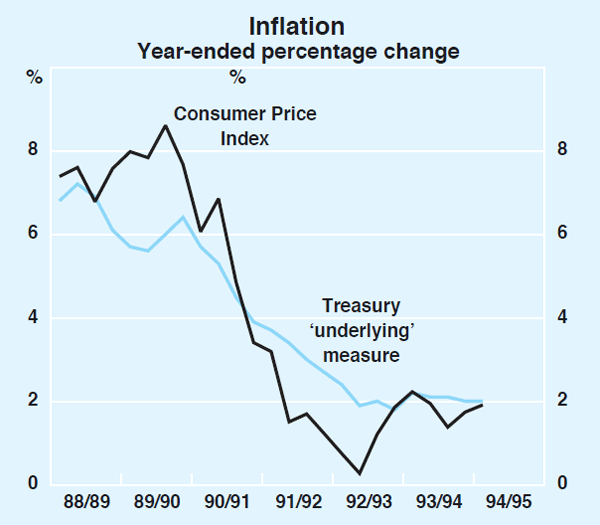
Despite these favourable outcomes, the deflationary phase of the cycle is now well behind us. With the economy growing fast, price expectations are less firmly anchored, and firms are looking for opportunities to lift prices in response to stronger demand. A critical issue is the degree of spare capacity – of both capital and labour – and the rate at which it is wound back.
Producer prices suggest some inflationary pressures may be emerging. Increases for the latest three months available (expressed as annual rates) have picked up for various price series, including those for the inputs used in house building (4.7 per cent, excluding timber), other building (2.5 per cent, excluding timber) and manufacturing (4.5 per cent, excluding petroleum). The price of articles produced by manufacturers (again excluding petroleum) rose by 2.8 per cent. Further details are provided in Table 2.
| Percentage change over year to period shown | ||||
|---|---|---|---|---|
| 1992 | 1993 | 1994 | Last 3 months | |
| Consumer Prices | ||||
| Consumer Price Index | 0.8 | 2.2 | 1.9 | 2.5 Sep qtr |
| Treasury underlying measure | 2.4 | 2.2 | 2.0 | 2.5 Sep qtr |
| Private consumption deflator | 1.6 | 1.8 | 1.4 | 0.7 Sep qtr |
| Producer Prices | ||||
| Manufacturing inputs (excl. petroleum) of which: |
7.5 | 2.1 | 1.0 | 4.5 October* |
| – domestic | 8.0 | −0.6 | 2.5 | 2.2 October* |
| – imported | 6.7 | 6.0 | −1.0 | 8.3 October* |
| Manufacturing output (excl. petroleum) | 2.3 | 1.9 | 1.7 | 2.8 October* |
| House-building materials (excl. timber) | 0.7 | 1.9 | 2.6 | 4.7 October* |
| Other building materials (excl. timber) | −0.5 | 0.9 | 2.1 | 2.5 October* |
| Import Prices | ||||
| Import price index | 10.2 | 7.2 | −4.6 | 0.2 October* |
| Imported items in CPI | −0.4 | 3.9 | 2.1 | 0.7 Sep qtr |
| Labour Costs | ||||
| Ordinary-time earnings | 3.2 | 2.8 | 3.0 | 1.9 August* |
| Average weekly earnings | 3.0 | 3.3 | 3.0 | 3.4 August* |
| Nominal unit labour costs | 1.8 | 0.0 | −0.5 | −7.2 Sep qtr |
| * For monthly series, figures are averages of the latest three months on the previous three months. | ||||
Some specific factors, including a downturn in housing activity and a stronger exchange rate, will help moderate these increases. On the other hand, continuing strong economic growth (both in Australia and abroad), declining unemployment, increasing capacity utilisation and, to a limited extent, the drought are likely to add to underlying inflationary pressures.
Headline inflation is expected to move above underlying inflation in the December quarter, reflecting recent increases in mortgage interest rates. For policy purposes, however, it is the underlying, rather than headline, rate of inflation that is most relevant.
Inflation expectations
Expectations of inflation over the short to medium term have deteriorated a little over the past few months. According to the ACCI-Westpac survey, the proportion of firms expecting to increase selling prices in the March quarter rose, although the proportion of firms expecting to hold their selling prices unchanged remains at historically high levels (see Graph 16).
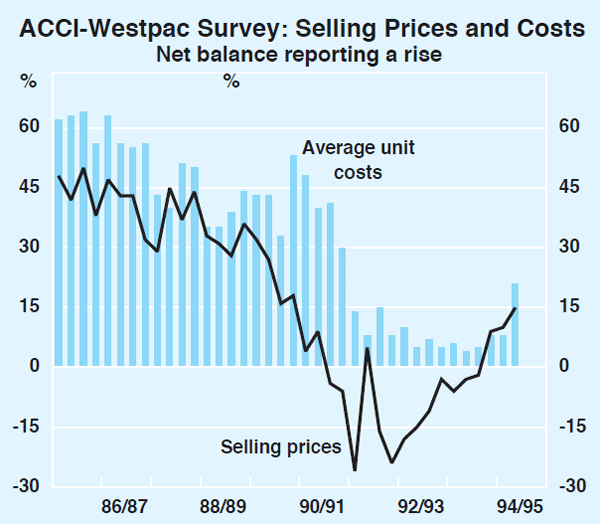
For 1995 as a whole, the average forecast of inflation by Consensus Economics increased from 3.5 per cent four months ago to 4.0 per cent in December, largely reflecting the impact of recent increases in mortgage interest rates on the headline CPI. The Melbourne Institute measure of consumers' inflation expectations over the next year rose slightly to 5.2 per cent in December, to be around the top of the range recorded in the past few years.
Financial market participants' expectations of inflation in the longer term have, if anything, eased a little over the past few months (see the section on financial markets).
The exchange rate
The higher exchange rate over recent months is operating to reduce, or at least hold down the rate of increase in, import prices. To the extent that lower import prices are being passed through to consumers, the appreciation of the Australian dollar should help mitigate inflationary pressures over the next few quarters. The pass-through of exchange rate movements to prices of goods ‘on the docks’ is fairly quick (being virtually complete within a year), although the pass-through to prices of goods ‘on the shelves’ takes considerably longer (with the bulk of the effect occurring within about two years of an exchange rate change).
Capacity utilisation
Capacity utilisation is difficult to gauge, but various measures shown in Graph 17 suggest it is continuing to rise.
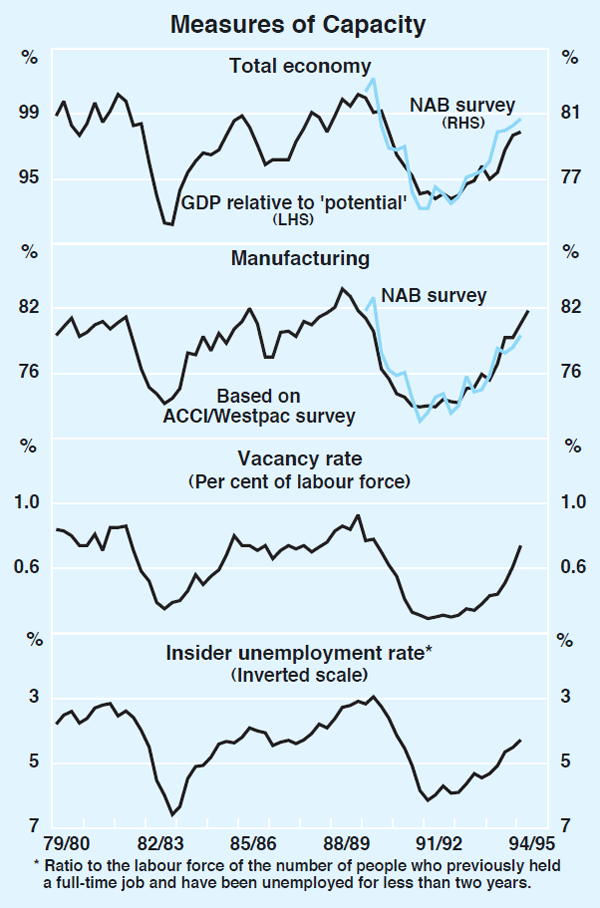
For the total economy, capacity utilisation now appears to be back to its average non-recessionary level. The ACCI-Westpac survey of the manufacturing sector (where both growth and investment have been stronger than in most other sectors) supports this view, with utilisation of the capital stock now at levels close to those recorded during the late 1980s.
In previous periods when output was close to ‘potential’ (based on this measure), inflation was often on the rise. Moreover, inflation tends to begin rising before ‘potential’ is reached. Recent, and projected, strong growth in expenditure on plant and equipment, while essential for a sustained recovery, is unlikely to translate into sufficiently strong growth of the stock of plant and equipment to avoid some further pressure on existing unused capital.
Wages and the labour market
Employment growth in the last year has been very strong (see Graph 18). Some 30,400 new jobs were created in November and employment has increased at an annualised rate of 4.3 per cent over the past six months. The extra jobs have been broadly based across the private sector, with the exception of agriculture and mining.
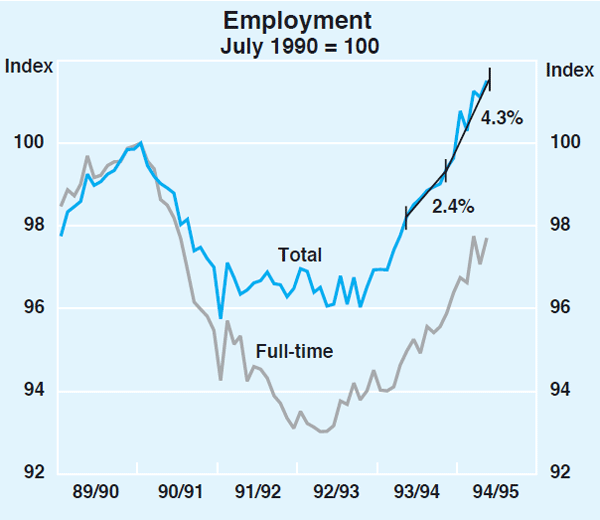
Various measures of job vacancy rates also suggest the labour market is tightening quickly. The ABS measure rose by 23 per cent over the three months to August to be 75 per cent higher than a year earlier. Vacancy rates in the private sector increased by 26 per cent and were close to the all-time peak recorded in May 1989. The ANZ Bank's measure fell slightly over the three months to December, but was still some 18 per cent higher than a year ago. The DEET measure of the skilled vacancy rate rose in December and has increased by around 50 per cent over the past year. Vacancy rates in most categories of skilled occupations are now approaching their average levels of the mid 1980s. Finally, overtime per employee remains around the highest levels seen in four years.
Despite the rise in employment in November, the unemployment rate rose marginally (to 9.3 per cent) as participation increased. The participation rate now appears to be responding to strong employment growth in much the same way as in previous cycles, and the rate at which participation rises will influence the pace of further reductions in the unemployment rate.
There have been some important compositional shifts in the labour market. To this time, fewer people are working full time than was the case at the peak of the last cycle in 1990. This may reflect labour supply changes, as much as demand: the number of unemployed people looking for full-time work has been falling almost continually for more than a year. By contrast, the number of unemployed looking for part-time work has remained roughly stable over the past year. Long-term unemployment has fallen by 64,600 since September 1993 – a relatively rapid fall compared with the previous cycle (see Graph 19). Much of this fall has been for males seeking full-time work (down 43,400), and might in part reflect the expansion of labour market programs. Measures of ‘insider unemployment’ (such as those who held a full-time job in the last two years and who are therefore most ‘job-ready’) tend to have more bearing on wage pressures than does the headline unemployment rate. These measures suggest that an element of slack remains in the labour market but that it is being taken up quickly.
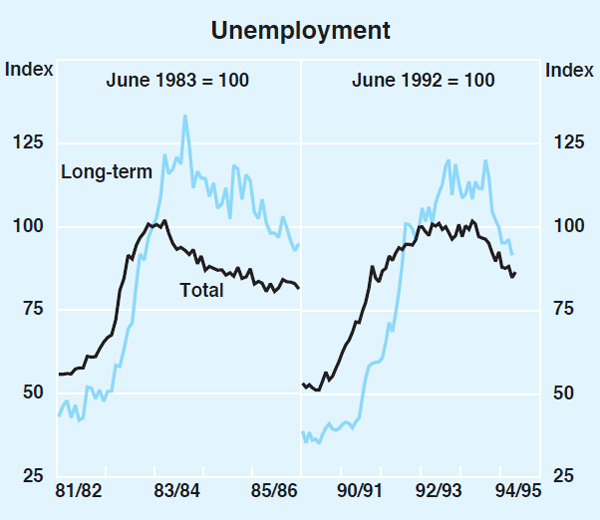
Wage increases recorded over the past year or so have been moderate. Annual increases in average weekly ordinary-time earnings of full-time adults, which provides an indication of underlying wage pressures, have remained around 3 per cent for over a year. Average weekly earnings of all employees, which includes the effects of both overtime and the earnings of part-time, casual and junior employees, are increasing at a similar rate. The national accounts measure of average earnings is also increasing at an annual rate close to 3 per cent (see Graph 20).
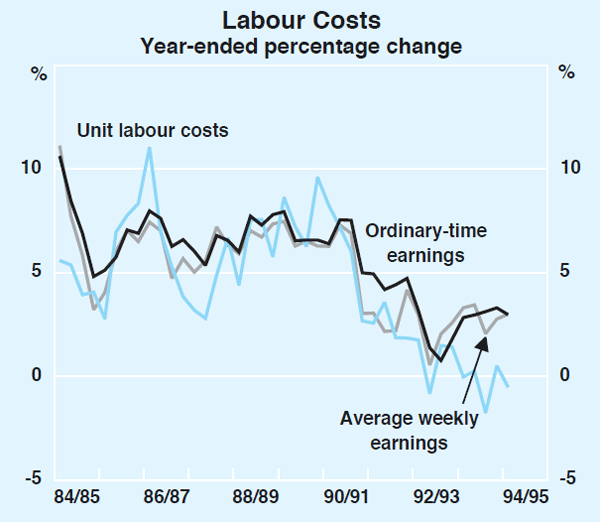
These wage increases have run somewhat ahead of inflation since 1988/89, suggesting that those with full-time jobs have experienced real wage increases of a little over 1 per cent per year (somewhat more in after-tax terms) – see Graph 21. This outcome has been consistent with low inflation because the increase in real wages has been broadly matched by gains in productivity. Income shares have returned to levels comparable with those observed prior to the 1970s. Productivity is expected to continue to grow at a relatively high rate although, at the corresponding stage of the last cycle, productivity growth began to slow considerably (see Graph 22). Further productivity increases are necessary for steady rises in real wages and living standards, combined with acceptable rates of inflation. All this will be put at risk, however, if average wage outcomes exceed the objective of underlying inflation of 2 to 3 per cent plus the average rate of productivity growth in the economy.
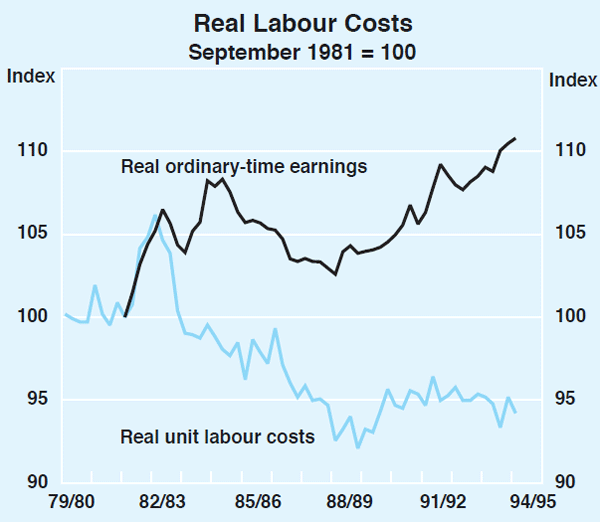
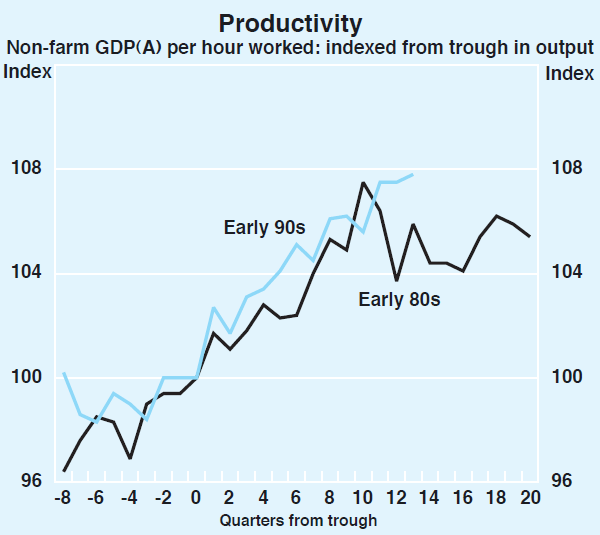
Momentum seems to be building on wages. In part, this comes from the gradual spread of enterprise agreements, which now cover one third of workers, with this coverage likely to rise to a half within a year or so. More importantly, the size of the agreements is creeping up, so that the most common annualised wage increases are now in the range of 4 to 5 per cent. For a number of them, the increases are considerably larger, notably those negotiated by the Transport Workers' Union. Over recent months, several unions have unveiled substantial wage claims which are being pursued industry-wide, rather than focused on individual enterprises.
While the overall wage outcomes so far have been consistent with price stability, there is little room for slippage. The aggregate outcome over recent years has not represented a decline in the aggregate real wage. So there is no general case for catch-up: if some groups have fallen behind, others must have run ahead. It would be easy for the large wage figures negotiated in these multi-year agreements to confuse negotiators on both sides as to the likely future inflation environment and the ability of the economy to sustain these increases. As noted earlier, wage increases in excess of 2 to 3 per cent plus productivity are not consistent with price stability, nor with a continuing sustained recovery; this point needs to be understood clearly by all the parties involved.
Financial Markets
Financial markets were generally surprised by the strength of economic activity in the December quarter, both in Australia and in a number of overseas countries. In contrast to the experience earlier in the year, when strong economic activity mainly put upward pressure on long-term interest rates because of concerns about the potential for inflation, the upward pressure in the December quarter was most evident in the short and medium-term parts of the yield curves. This shift in pressure reflected both greater confidence by market participants that the authorities will act to control inflationary pressures and an expectation of further increases in official interest rates.
The cash rate in Australia was raised twice during the December quarter, by one percentage point on 24 October and by a further one percentage point on 14 December. These increases, which lifted the cash rate to 7.5 per cent, had been widely expected in the markets. A reflection of this was that short-term security yields traded above the prevailing cash rate throughout the quarter, as shown in Graph 23. At the end of the quarter, the yield on 90-day bank bills was 8.3 per cent, up about two percentage points over the quarter.
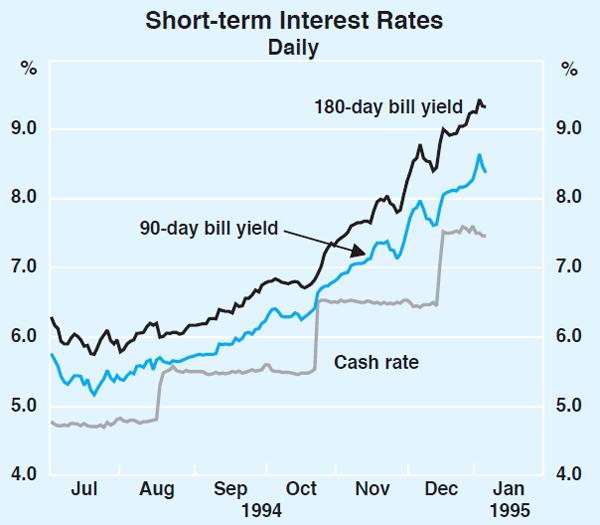
Monetary policy was also tightened in several other countries which are at relatively advanced stages of the economic cycle. In the United States, the Federal Reserve raised the cash rate by 0.75 of a percentage point to 5.5 per cent in mid November. This was the sixth tightening since February and brought the total increase in the Fed Funds rate to 2.5 percentage points. In the UK and Canada, rates rose by about 0.5 of a percentage point, while in New Zealand the increase was about 2 percentage points. Movements in cash rates in these countries since February 1994, when the Fed started to tighten, are summarised in Table 3.
| Movement between February and December 1994 |
Level at end December 1994 |
|
|---|---|---|
| Australia | 2.75 | 7.5 |
| United States | 2.5 | 5.5 |
| United Kingdom | 1.0 | 6.25 |
| Canada | 2.0 | 5.5 |
| New Zealand | 3.5 | 8.25 |
Long-term bond yields in most countries continued to rise early in the quarter but, as it became clear that the authorities were prepared to take policy action to contain potential inflationary pressures, yields eased back. In Australia, yields on 10-year bonds reached a high of 10.75 per cent mid quarter, but fell to 10 per cent by the end of the quarter, much the same as the level at the end of the previous quarter. The flat outcome for the quarter contrasted with the sharp rises in the first three quarters of 1994. As can be seen from Graph 24, long-term bond yields in most countries flattened out during the quarter, and Australian yields remain high by world standards (and had crept back to 10.4 per cent on 9 January).
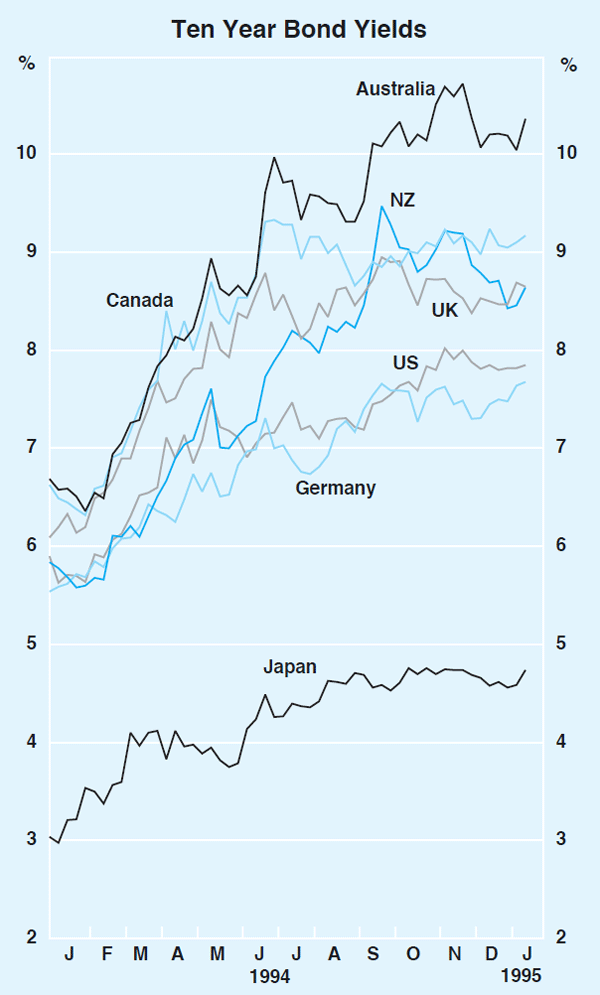
Yields on short and medium-term bonds rose quite sharply during the quarter, both in Australia and in a number of other countries. In Australia, the yield on three-year bonds rose from a little over 9 per cent to over 10 per cent. These movements resulted in the yield curve becoming flat for maturities between two and ten years (see Graph 25). In the US, the yield curve also flattened significantly during the quarter, with yields for the maturities between two and ten years mostly around 8 per cent.
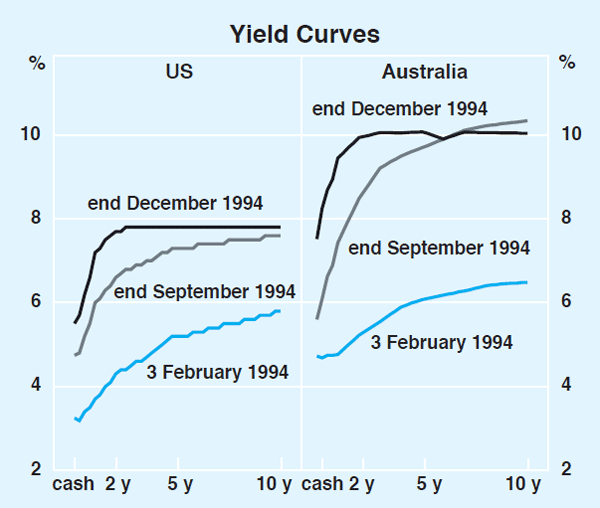
Share markets
Downward pressure on share prices continued in the December quarter as rising interest rates made shares less attractive. The All Ordinaries Index of share prices fell by 6 per cent over the quarter, to 1913. It eased by a further 2 per cent in early January. Share prices in Australia in early January were about 20 per cent below their peak last February. As can be seen from Graph 26 this fall was larger than the fall in US share prices over the period, but the rise in Australian share prices in the second half of 1993 had also been larger than in the US; the net movement over the whole period was similar in both countries.
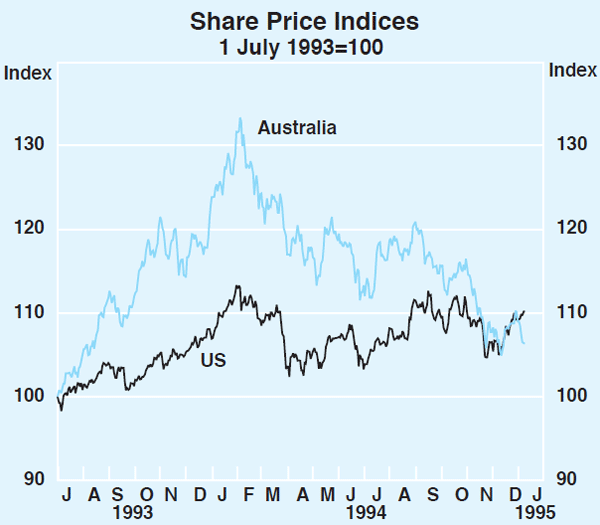
In Japan and most European countries, share prices were up marginally over the quarter. In other Asian countries, however, they were down sharply. Hong Kong and Malaysia experienced the biggest falls both falling by about 14 per cent (see Table 4). Further falls were experienced in most of these countries in early January.
| December Quarter |
Year to 31 December |
|
|---|---|---|
| USA | −0.2 | 2.1 |
| Japan | 0.8 | 13.2 |
| Germany | 4.7 | −7.1 |
| Australia | −5.7 | −12.0 |
| UK | 1.3 | −10.3 |
| Hong Kong | −14.0 | −31.1 |
| Malaysia | −14.0 | −23.8 |
| Singapore | −4.0 | −7.7 |
| South Korea | −2.2 | 18.6 |
| Taiwan | 0.3 | 17.1 |
Foreign exchange markets
After having traded around a flat trend since February, the Australian dollar rose noticeably in the December quarter, driven by strong overseas demand by investors seeking to take advantage of the rise in world commodity prices. The exchange rate ended the quarter at 56.2 on the trade-weighted index, and US77.7 cents. This was around 5 per cent higher than three months earlier. Some of these gains were reversed in early January following the publication of figures for the current account deficit. On 9 January, the Australian dollar was standing at 55.7 in trade-weighted terms, and at US76.4 cents (see Graph 27). Notwithstanding the net rise in recent months, the exchange rate remains below its longer-term average, in trade-weighted terms (see Graph 28). The Bank did not intervene in the foreign exchange market in the December quarter.
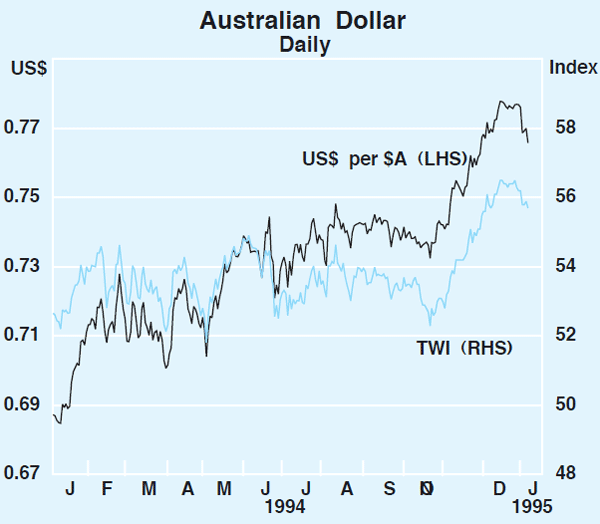
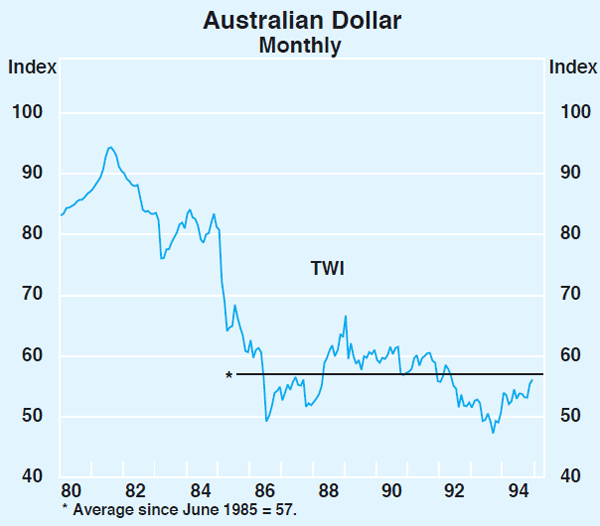
The US dollar was volatile in the December quarter. It came under heavy selling pressure in October, against both the mark and the yen but, following successful intervention by the Fed in late October, sentiment improved. It also received a boost from the increase of 0.75 of a percentage point in the Fed funds rate in mid November, which was larger than the market generally had been expecting. Although there were a couple of bouts of selling in late December and early January, the US dollar remained about 3 per cent above the low points reached in October.
Financial intermediaries
The tightening of monetary policy during the quarter led to further rises in intermediaries' interest rates. The October tightening prompted only a partial response from banks, as had been the case in the earlier tightening in August. Banks which had not raised interest rates on housing and business loans after the August tightening raised these rates by around three quarters of a percentage point, while most banks that had responded to the August tightening raised their loan rates by lesser amounts. Following the December tightening, all the major lenders increased rates on housing and business loans by about 1 percentage point. The net effect of these changes is that banks generally have absorbed about 1 percentage point of the 2.75 per-centage point rise in the cash rate since August. The major banks' variable-rate housing loan now ranges between 10.5 and 10.75 per cent; the range for the indicator rate for smaller businesses is 10.9 to 11.5 per cent.
Interest rates on credit cards have been increased by between 1.2 and 2.5 percentage points in response to the increases in cash and related rates. Rates charged by the major banks on credit cards with an interest free period now range between 15.9 per cent and 16.45 per cent.
Interest rates on some bank deposits (cash management accounts, fixed term deposits and certificates of deposit) rose substantially during the quarter in response to the monetary tightenings and movements in market yields. Interest rates on savings and transaction accounts, however, rose by lesser amounts. Two major banks increased rates on some of these deposits, on average by about 0.25 of a percentage point, following the December tightening. This was the first significant increase in interest rates on these classes of deposits in the current round of policy tightenings. Other banks have left rates on these deposits unchanged. The limited response by banks in respect of these deposits to date presumably reflects limited net outflows from such deposits and, therefore, the absence of pressure to raise rates.
Intermediaries' credit outstanding to the private sector grew at an annual rate of 9.5 per cent over the three months to November, compared with 12.1 per cent over the previous three months. Growth of housing credit slowed to (a still strong) 17 per cent; business credit increased by 4.5 per cent (annual rate) over the same period (see Graph 29).
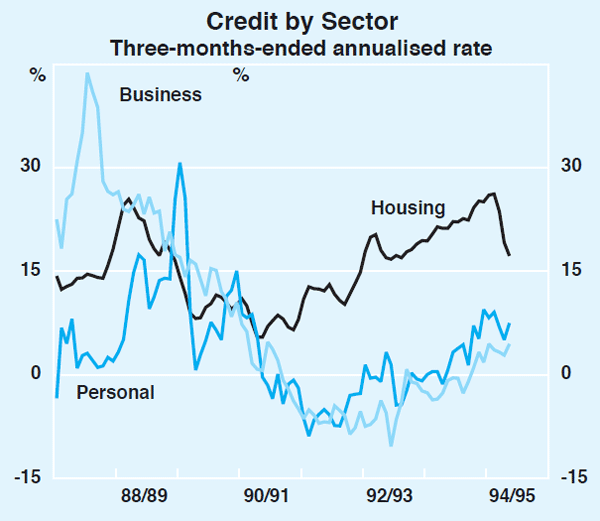
Recent growth of the broader monetary aggregates, M3 and broad money, is consistent with the growth of total credit. M1, however, contracted at an annualised 5.5 per cent over the three months to November, following very rapid rates of increase earlier in the year.